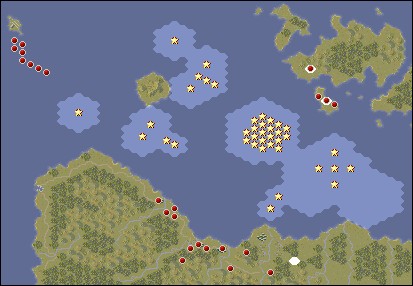 When you move the mouse pointer over the map, unit name, strength and coordinates are displayed as a label. When you press terrain button object name is displayed (city, river, sea, ...) |
Savo
9.8.1942
PacPG: 7.8.1942 - 9.8.1942
Scenario Map:
|
|
|
Changes and corrections of map:
|
Scenario author: Scenario origin: Last revision date: |
stanny 26.2.2005 27.3.2011 |
First release: Revision released: |
4.4.2011 ( Relase 02 ) - |
| One of the scenarios, which are not executable in PacG, but their maps are ready for enthusiasts who would like to use them for create new scen. This theme specifically fulfiled wish of stanny. The original map of PacG was a little bit inaccurate, therefore the map was created entirely again with larger dimensions, the better suited to implement naval battles. Was added laso the island of Tulagi and small islands Tanambogo and Gavutu which was completely ignored on the original map. |
Original map:
|
|
|
Historic overview:
Article on Czech Wikipedia Article on English Wikipedia
| ||||||||||||||||||||||||||||||||||||||||||
Game play matters:
| Campaign play: In a scenario will take place at the Battle of Savo Island, at the same time it is necessary to make landings at Guadalcanal, occupy Henderson Field and make landings at Tulagi and Florida. The defeat means the end of the campaign, after both Major or Minor victories follows Guadalcanal scen. Scenario rarities: Japanese air force supported the struggle for Guadalcanal from their base at Rabaul, which is of course very far from the island due to the scale and range maps. To allow Japanese aircraft could operate, in this scen is Rabaul base simulated by fictional island with an airport in the corner of the map in the direction of Rabaul. The attacking side as the enemy attacking from the sea to the island at the beginning of the battle has no strategic ground point. The role of an initial point performs virtual and unpossible to occupy strategic hex in the sea. |
Scenario data:
|
Map size: 52 x 35 hexes 16 turns, 6 turns per day Version: PacAGPG 1, Starting side: Allies, Campaign: US campaign, Order in campaign: 2. |
||||||||
|
||||||||
|
||||||||
|
||||||||
|
||||||||
|
Game time costingness of scenario: 15.2 % (product of units and turns numbers divided by difference between the most long and the most short scenario) |
||||||||
|
Number of Allied units: 53 units, from them are 7 core units and 46 auxiliary units 14 air units, 18 naval units and 21 ground units 0 of units are loaded to air transport and 21 to naval transport |
Transports Air/Naval: Allies - Axis 0/22 - 0/0 |
|||||||
|
Number of Axis units: 38 units 14 air units, 8 naval units and 16 ground units 0 of units are loaded to air transport and 0 to naval transport |
Initial prestige + every turn donation: Allies / Axis 150 + 0 / 330 + 0 |
|||||||
|
Max number of Allied units: 53 units, from them are 7 core units and 46 auxiliary units - on start of scenario is possible to purchase 0 unit (0 core + 0 auxiliary) |
||||||||
|
Max number of Axis units: 41 units - on start of scenario is possible to purchase 3 unit |
||||||||
Transport units:
|
||||||||
|
| Allied units: Sea Bees (USA) Marines 41 (USA) Bridge Engineers (USA) Para 41 (USA) Infantry 41 (USA) Infantry HW 41 (USA) US M2A4 (USA) M3 Stuart (USA) 37mm ATG (USA) US 75mm Gun (USA) US M3 Gun Motor Carriage (USA) US 90mm AD (USA) 20mm AD (USA) F4F Wildcat (USA) TBF Avenger (USA) SBD Dauntless (USA) Destroyer (USA) Light Cruiser (USA) Heavy Cruiser (USA) US M2 Halftruck (USA) US GM Truck (USA) AF Transport (USA) Light Cruiser (Australia & New Zealand) Heavy Cruiser (Australia & New Zealand) |
Axis units: Hohei 1940 (Infantry 1940) (Japan) Shinhoto Chi-Ha (Japan) Type 97 Chi-Ha (Japan) Type 95 Ha-Go (Japan) H6K Mavis (Japan) Type 91 105mm (Japan) Meiji 38 Improved 75mm Field Gun (Japan) Type 98 20mm (Japan) A6M2 Zero (Reisen) (Japan) G4M Betty (Rikko) (Japan) D3A Val (Japan) Destroyer (Japan) Light Cruiser (Japan) Heavy Cruiser (Japan) Isuzu Type 94 6-Wheeled Truck (Japan) |
The same time period scenarios:
| India (PacAGPG 2), New Guinea 42 (PacPG 1), Tulagi (PacAGPG 2) |
| Airfield Cape Esperance Gavutu Halavo Peninsula Haleta Hoilava River Indispensable Sound Kamimbo Bay Koli Point Kukumbona Display all mapnames in list... |
Tactical map (large & detail):

|
|
|
|
Basic map |
|
|
Map with unloaded transports and order numbers of units |
Battlefield map:

|
|